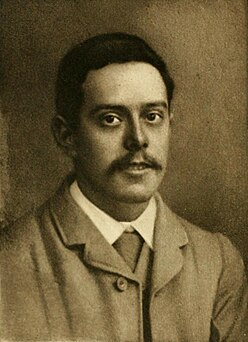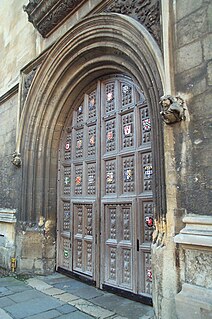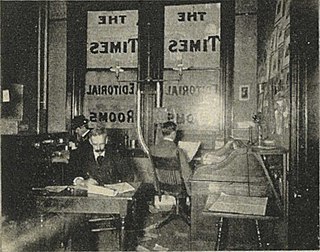
Le Roman de la Rose is a medieval French poem styled as an allegorical dream vision. It is a notable instance of courtly literature. The work's stated purpose is to both entertain and to teach others about the art of romantic love. Throughout the poem, Rose is used both as the name of the titular lady and as a symbol of female sexuality. The other characters' names also function both as regular names and as abstractions illustrating the various factors that are involved in a love affair.

The Gutenberg Bible was among the earliest major books printed using mass-produced movable metal type in Europe. It marked the start of the "Gutenberg Revolution" and the age of printed books in the West. Widely praised for its high aesthetic and artistic qualities, the book has iconic status. It is an edition of the Vulgate printed in the 1450s in Latin by Johannes Gutenberg in Mainz, in present-day Germany. Forty-nine copies have survived. They are thought to be among the world's most valuable books, although no complete copy has been sold since 1978. In March 1455, the future Pope Pius II wrote that he had seen pages from the Gutenberg Bible displayed in Frankfurt to promote the edition. It is not known how many copies were printed; the 1455 letter cites sources for both 158 and 180 copies. The 36-line Bible, said to be the second printed Bible, is also referred to sometimes as a Gutenberg Bible, but may be the work of another printer.

Thomas James was an English librarian, first librarian of the Bodleian Library, Oxford.
Octavo, a Latin word meaning "in eighth" or "for the eighth time", is a technical term describing the format of a book, which refers to the size of leaves produced from folding a full sheet of paper on which multiple pages of text were printed to form the individual sections of a book. An octavo is a book or pamphlet made up of one or more full sheets of on which 16 pages of text were printed, which were then folded three times to produce eight leaves. Each leaf of an octavo book thus represents one eighth the size of the original sheet. Other common book formats are folios and quartos. Octavo is also used as a general description of size of books that are about 8 to 10 inches tall, and as such does not necessarily indicate the actual printing format of the books, which may even be unknown as is the case for many modern books. These terms are discussed in greater detail in book sizes.

Codicology is the study of codices or manuscript books written on parchment as physical objects. It is often referred to as 'the archaeology of the book', concerning itself with the materials, and techniques used to make books, including their binding.

The Incunabula Short Title Catalogue (ISTC) is an electronic bibliographic database maintained by the British Library which seeks to catalogue all known incunabula. The database lists books by individual editions, recording standard bibliographic details for each edition as well as giving a brief census of known copies, organised by location. It currently holds records of over 30,000 editions.
Alain (Alanus) was a Cistercian abbot of La Rivour, and bishop of Auxerre from 1152 to 1167. He was a close associate of Bernard of Clairvaux, who was instrumental in getting him appointed bishop, under commission from Pope Eugene III, after a dispute in the diocese. Alain was one of Bernard's biographers.

Quarto is a book or pamphlet produced from full "blanksheets", each of which is printed with eight pages of text, four to a side, then folded twice to produce four leaves. The leaves are then trimmed along the folds to produce eight book pages. Each printed page presents as one-fourth size of the full blanksheet.
A book prospectus is a printed description of or advertisement for that book, usually issued before publication in an attempt to generate interest and advance orders. The word derives from Latin, meaning literally something which gives a view or prospect. Some prospectuses are lavishly produced, especially for private press books.

The Mainz Psalter was the second major book printed with movable type in the West; the first was the Gutenberg Bible. It is a psalter commissioned by the Mainz archbishop in 1457. The Psalter introduced several innovations: it was the first book to feature a printed date of publication, a printed colophon, two sizes of type, printed decorative initials, and the first to be printed in three colours. The colophon also contains the first example of a printer's mark. It was the first important publication issued by Johann Fust and Peter Schoeffer following their split from Johannes Gutenberg.
Theoderic Rood was a printer of incunabula at Oxford, England. His activities in the city can be dated with any certainty only to the years 1481 and 1482, but probably extend between around 1481 and 1484. Several earlier printed books, dating from 1478 and 1479, and an edition of John Mirk's Liber festivalis of 1486 or 1487, which were once attributed to Rood's press are now thought to be the work of other, as yet unidentified, printers.
Edward Gordon Duff, known as Gordon Duff, was a British bibliographer and librarian known for his works on early English printing.

Robert George Collier Proctor was an English bibliographer, librarian, book collector, and expert on incunabula and early typography.
The Lyell Readership in Bibliography is an endowed annual lecture series given at Oxford University. Instituted in 1952 by a bequest from the solicitor, book collector and bibliographer James Patrick Ronaldson Lyell (1871–1948), the series has continued down to the present day. Together with the Panizzi Lectures at the British Library and the Sandars Lectures at Cambridge University, it is considered one of the major British bibliographical lecture series.

As of 2018, seven firms in the United Kingdom rank among the world's biggest publishers of books in terms of revenue: Bloomsbury, Cambridge University Press, Informa, Oxford University Press, Pearson, Quarto, and RELX Group.
Richard Pafraet was a medieval Dutch printer.



















